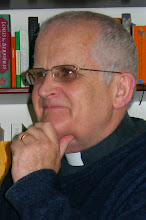26:57- 75 Confession and Denial
Jesus’ confession is contrasted with Peter’s denial by means of a “sandwich structure” which tells us that two things are happening at the same time: Jesus’ is taken into Caiaphas’ house, Peter is hanging around outside, Jesus is questioned and confesses, Peter is questioned and denies. This provides a connection between the two incidents and also makes for an ironic contrast. This is the overall setting.
On the assumption of Matthew using Mark as his major source, we see changes made that could be understood as corrections of what we have called [in the Markan blog] Mark’s “rough spots”. (i) There is one high priest and he is Caiaphas, (ii) the repetition of the inadequacy of the witnesses is toned down, (v) the trial before Pilate is made distinctive by the addition of new material.
Here are still “rough spots”: (iii) the function of the first (temple) charge is perhaps even less clear with “not made by hands” removed. The second (blasphemy) charge is not clear – there is no use or abuse of the name!
The motivation for this “arraignment” from the point of Matthew’s community is not too hard to see. The Jerusalem leadership’s opinion “he deserves death” comes at the conclusion of their opposition to the preaching in Matthew’s story. This group of characters in Matthew’s story will admit culpability in 27:25.
Were we to attempt to go behind Matthew’s story and look for historical verisimilitude we would run into the problems that have been discussed over the years: (i) Is this in any sense a “Jewish trial” of Jesus by a legally constituted group, such as the Sanhedrin? (ii) Pilate was known to be a “hanging judge” who did not shared neither his power nor his hated of Jews. He alone can pass, and carry out, a death sentence. (iii) The whole wife-warning, hand-washing no-fault thing tells us about Matthew’s need for “Christians” to appear to Rome as the “good guys”, not about the historical Pilate. What is realistic is that Jesus was a challenge to the Jewish and Roman authorities and, particularly at the well-known flash point of Passover, had to be dealt to. “Thus Jesus was probably viewed as one in a series of political-religious messianic pretenders in first-century Palestine.”(Harrington, 383)
Matthew reduces the complexity of Mark’s “Christological tableau” (Mk. 14:61-62) but Jesus’ response “you say so”, to the high priest’s question (“tell us if you are the Messiah, the Son of God”) is no less direct that Mark’s “I am”. We have already met the circumlocution “you say so” in the “is it I, Lord” sequence at the Last Supper. When Judas says “Surely not I, Rabbi?” Jesus responds “you say so”(Matt 26:25). Jesus’ response means “You’ve got that right!” It does not mean: “they are your words, not mine!”
Why did Jesus say Peter would deny him three times? Perhaps to distinguish it from a mistake: more likely to make a good story. Three strikes and you’re out! Just as Jesus faces two charges, so too does Peter: (i) he has been “with Jesus” and (ii) his accent betrays him as being “one of them”. Matthew has omitted Mark’s “he called them to be with him” (Mk 3:14) from the appointing of the twelve but we hear it here anyway. This seems to be the more damning of the “charges” although it comes like a toss away remark. Peter “doth protest too much”, twice, and he begins to back his way outside (vv. 71, 75).
There is a progression as Peter digs himself deeper into a hole (i) A chance remark by a serving girl to Peter is denied in front of everyone. (ii) Peter moves outside onto the porch and a different servant girl makes the same remark, this time to the larger audience that Peter has created, and Peter responds with a (forbidden) oath of denial. (iii) The crowd, sensing blood, closes in on Peter and he totally looses it and swears an oath: Ï do not know the man!” How “Clintonesque”.
Peter’s three-fold denial had been prophesied as coming before the night is out (“cock crow” is about half an hour before “sparrow fart”). Three fold confession is usually balanced off by three-fold denial. In the Fourth Gospel the three-fold denial is countered by the three-fold “do you love me?” (Jn. 21:15ff)
One other thing to note is the use of oaths and curses by both the Jerusalem authorities (“I put you under an oath before the living God, tell us”) and Peter (“Then he began to curse and he swore an oath”). Matthew’s Jesus had taught (Matt. 5:33-37) not to swear oaths but to let your “Yes” be “Yes” and your “No” be “No”.

No comments:
Post a Comment